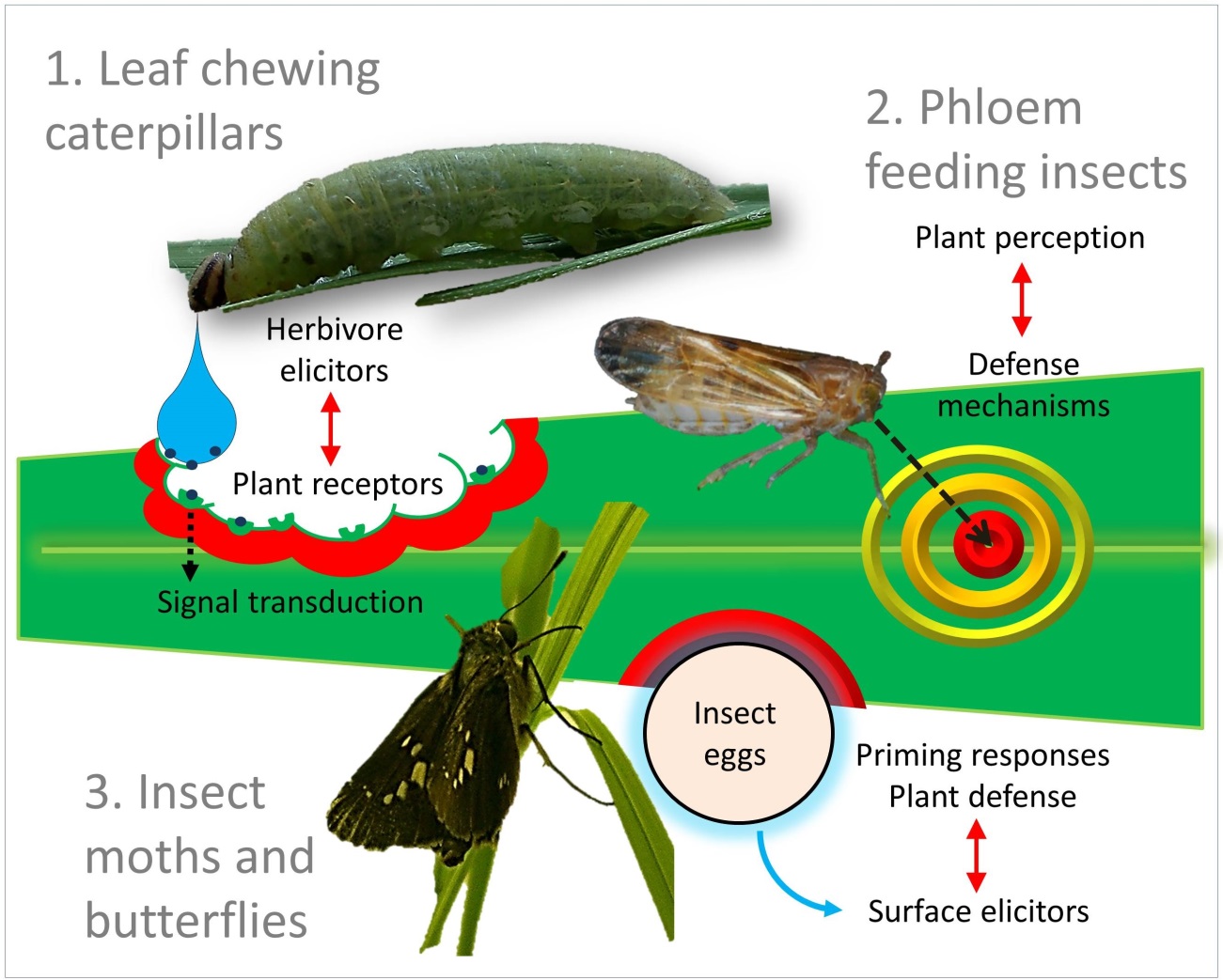Plant-Insect Interactions
Research Groups
Group of Plant-Insect InteractionsStaff
Research Topics
Elucidation of plant-insect interactions at the molecular level
|
Establishment of effective plant defense systems against herbivores in natural history reflects the existence of extremely variable interactions between plants and insects, also known as co-evolution process. Our group strives to understand, at a molecular level, the mechanisms of activation, signal transduction and metabolic basics of plant defenses triggered after the recognition of insect attack. Furthermore, we target sustainable pest control by the use of natural enemies and their attraction to herbivore-infested plants by the emissions of various volatile organic compounds (VOCs) from plants.
|
Understanding of metabolic defense against herbivores in plants
|
Plants activate powerful protective shield against feeding herbivores that involves biosynthesis of various toxic phytoalexins. While spectrum of phytoalexins in plants is vast, their biosynthesis and regulation during herbivory are less known. We use monocot plant models, including rice and sorghum, to identify novel metabolic patterns associated with herbivory. We look for transcriptional regulators involved in the regulation of biosynthetic genes for these compounds, in particular those induced in response to herbivore attack. We also study the role of plant hormones as secondary messengers in defense signaling pathways against herbivores. |
Research on perception of herbivory in plants
|
The strength of plant defense largely depends on early detection of elicitor molecules from herbivores which are deposited in plant wounds during feeding. As the number of identified elicitors is still limited, we aim identification of novel elicitors using rice plants and their herbivores as our model systems. We develop efficient bioassays for rapid detection and isolation of novel compounds, use biochemical techniques for their characterization, and intact plants for functional analyses of these novel herbivory-associated molecular patterns (HAMPs). |
Publication List
- Shinya, T., Miyamoto, K., Uchida, K., Hojo, Y., Yumoto, E., Okada, K., Yamane, H., and Galis, I. (2022) Chitooligosaccharide elicitor and oxylipins synergistically elevate phytoalexin production in rice. Plant Mol Biol. in press
- Wari, D., Aboshi, T., Shinya, T., and Galis, I. (2022) Integrated view of plant metabolic defense with particular focus on chewing herbivores. J Integr Plant Biol. 64: 449-475.
- Mujiono, K., Tohi, T., Sobhy, I.S., Hojo, Y., Shinya, T., and Galis, I. (2021) Herbivore-induced and constitutive volatiles are controlled by different oxylipin-dependent mechanisms in rice. Plant Cell Environ 44: 2687-2699.
- Mujiono, K., Tohi, T., Sobhy, I.S., Hojo, Y., Ho, N.T., Shinya, T., and Galis, I. (2020). Ethylene functions as a suppressor of volatile production in rice. J. Exp. Bot. 71: 6494-6511.
- Andama, J.B., Mujiono, K., Hojo, Y., Shinya, T., and Galis, I. (2020). Nonglandular silicified trichomes are essential for rice defense against chewing herbivores. Plant Cell Environ. 43: 2019-2032.
- Shinya, T., Shibuya, N., Kaku, H. (2020). Affinity labeling and purification of plant chitin-binding LysM receptor with chitin octasaccharide derivatives. In: Hirabayashi J. (eds) Lectin Purification and Analysis. Methods Mol. Biol. 2132:401-412.
- Wari, D., Alamgir, K.Md., Mujiono, K., Hojo, H, Shinya, T., Tani, A., Nakatani, H., and Galis, I. (2019). Honeydew-associated microbes elicit defense responses against brown planthopper in rice. J. Exp. Bot. 70: 1683-1696.
- Wari, D., Alamgir, K.Md., Mujiono, K., Hojo, Y., Tani, A., Shinya, T., Nakatani, H., Galis, I. (2020). Brown planthopper honeydew-associated symbiotic microbes elicit momilactones in rice. Plant Signal. Behav. 14: 1655335.
- Shinya, T., Yasuda, S., Hyodo, K., Tani, R., Hojo, Y., Fujiwara, Y., Hiruma, K., Ishizaki, T., Fujita, Y., Saijo, Y., and Galis, I. (2018). Integration of danger peptide signals with HAMP signaling amplifies the anti-herbivore defense responses in rice. Plant J. 94: 626-637.
- Sobhy, I.S., Miyake, A., Shinya, T., and Galis, I. (2017). Oral secretions affect HIPVs induced by generalist (Mythimna loreyi) and specialist (Parnara guttata) herbivores in rice. J. Chem. Ecol. 43: 929–943.
- Shinya, T., Hojo, Y., Desaki, Y., Christeller, J.T., Okada, K., Shibuya, N., and Galis, I. (2016). Modulation of plant defense responses to herbivores by simultaneous recognition of different herbivore-associated elicitors in rice. Sci. Rep. 6: 32537.
- Alamgir, K.Md., Hojo, Y., Christeller, J.T., Fukumoto, K., Isshiki, R., Shinya, T., Baldwin, I.T., and Galis, I. (2016). Systematic analysis of rice (Oryza sativa) metabolic responses to herbivory. Plant Cell Environ. 39: 453-466.
